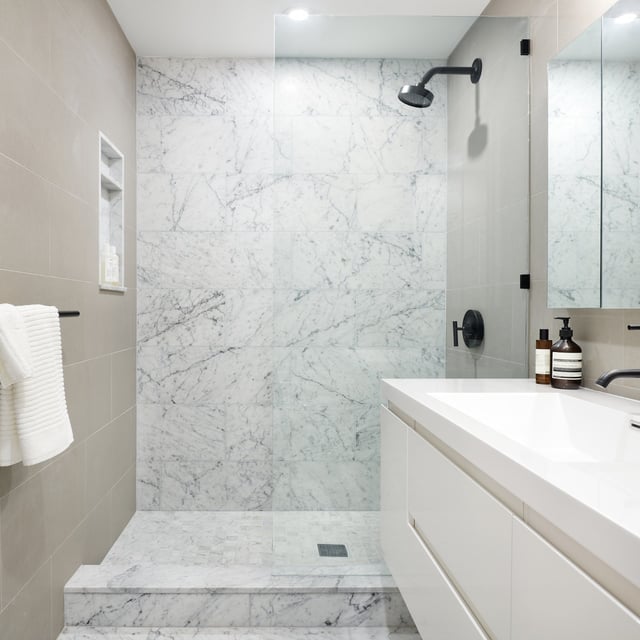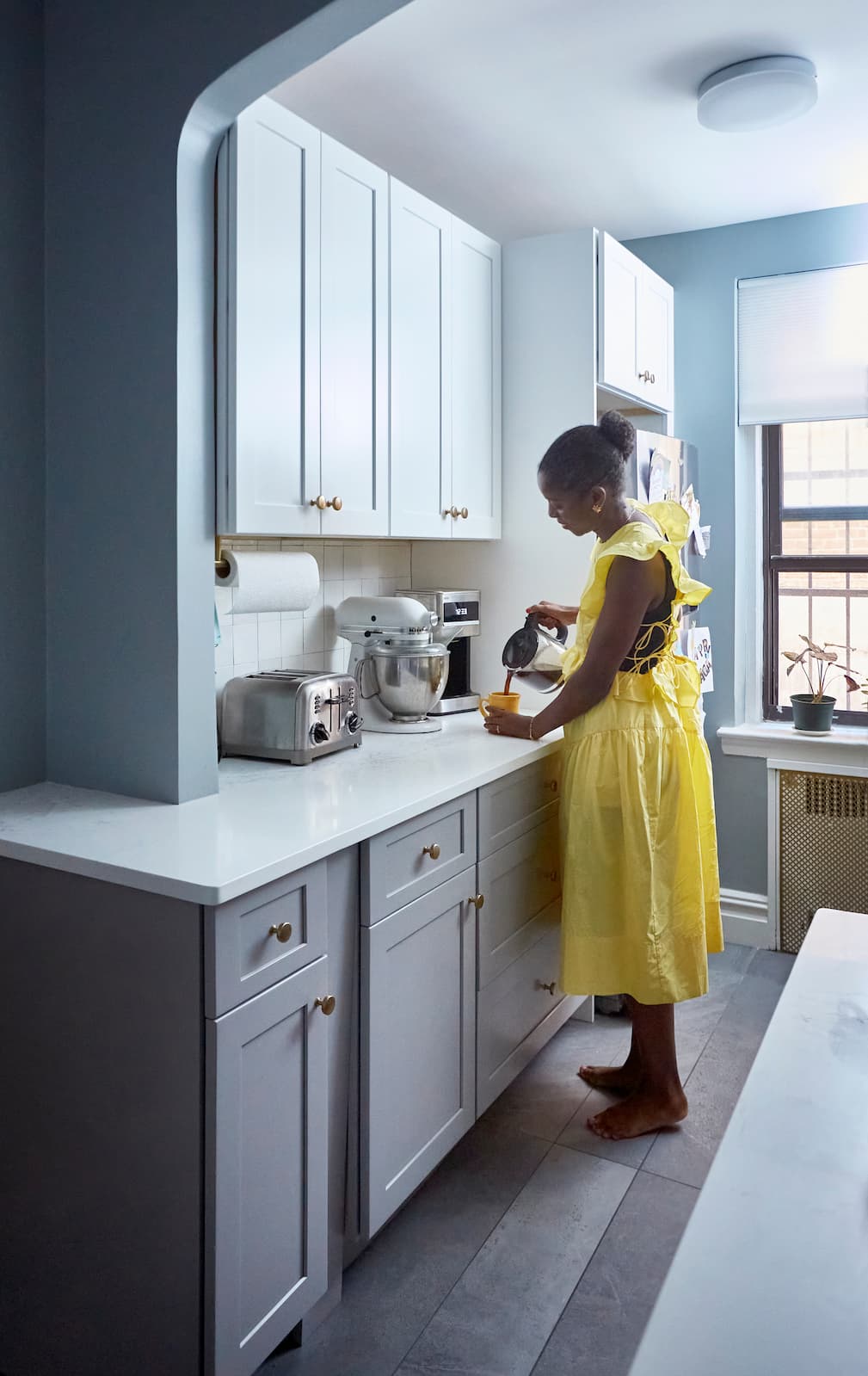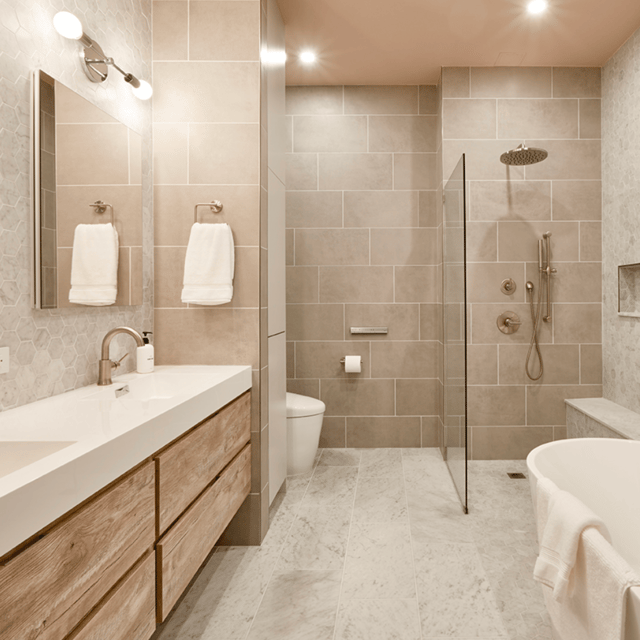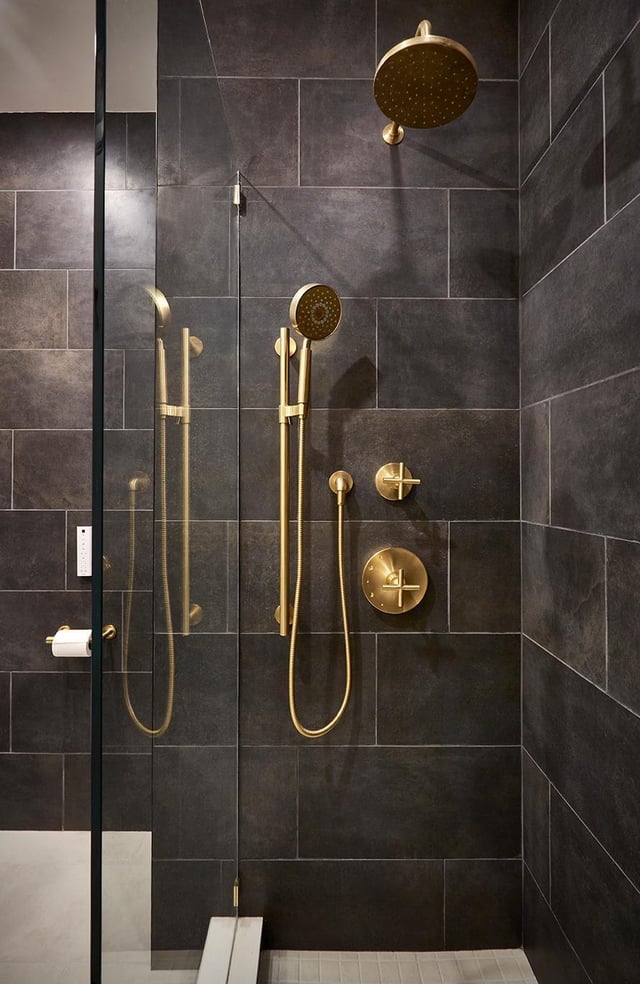
Bathroom
Eco-Friendly Shower & Bathroom Ideas
12.23.2025
Our New Year savings event is here: Get up to $6,500 off your project today (terms apply).


In This Article
Marble has a way of evoking quiet luxury—cool stone under bare feet, soft light across veined surfaces, the calm elegance of a hotel bathroom or a museum hall. We think of checkerboard floors, cloud-like slabs, and that unmistakable mix of texture and polish.
In a bathroom, those qualities create a space that feels both serene and elevated. But marble isn’t just about aesthetics. To use it well, it’s worth knowing where it works best, how it holds up over time, and what kind of care it requires.
Design a Home That’s Uniquely Yours
Block can help you achieve your renovation goals and bring your dream remodel to life with price assurance and expert support.
Get Started
To further refine your marble flooring design, read Small Bathroom Flooring Ideas That Make a Big Impact and Bathroom Waterproofing—Floors, Walls & More.
Read A Guide to the Best Materials to Use on Shower Walls for more guidance on using marble and similar materials within your bathroom.
Perfect Every Detail of Your Bathroom

Pull secondary tones from your marble—soft gray, taupe, or blue‑gray—and repeat them in grout, wall paint, and textiles for a cohesive palette. If your vanity top leans cool, choose brushed nickel hardware and a pale gray wall to echo the veining. For warmer marbles, bring in sand‑colored towels and a light oak mirror frame to balance the temperature. This repetition ties floors, counters, and fixtures together without competing patterns.
 Check out this New York bathroom
Check out this New York bathroom
Soft gray cabinetry grounds white marble and makes the movement read clearly. Try a graphite vanity with a honed marble bathroom floor and satin nickel fixtures for a calm, unified tone. A medium‑gray grout will outline tiles subtly and reduce the look of day‑to‑day wear. Finish with smoked glass accents or a gray linen shower curtain to add texture without adding color.
 Check out how this bathroom paired marble with gray
Check out how this bathroom paired marble with gray
Blues highlight the blue‑gray undertones found in many marbles and make whites feel crisper. Try navy vanity fronts with brushed nickel pulls, a pale blue wall, and honed Carrara on the counter. Add a denim‑toned bath mat and sky‑blue towels to carry the color through the room. Keep metal finishes cool to maintain harmony across surfaces.
 View this modern bathroom design
View this modern bathroom design
Balance cool white marble with limestone, travertine, or warm‑beige marble to create a welcoming mix. A marble shower paired with a warm stone bathroom floor softens the contrast and adds visual warmth. Brushed brass or aged bronze fixtures echo the warmth without stealing focus. Cream grout can further soften transitions between materials.
 Check how this bathroom combines marble with natural stone
Check how this bathroom combines marble with natural stone
In an all‑white scheme, marble brings movement and texture without introducing color. A honed marble floor with white walls and a white vanity feels layered rather than stark. Keep hardware simple and choose a low‑sheen paint to echo the stone’s finish. Ribbed glass sconces and a white oak stool add quiet warmth and dimension.
 See how this white bathroom incorporates marble
See how this white bathroom incorporates marble
High‑contrast slabs, such as bold Calacatta or Panda, can anchor the room as a feature wall or shower surround. Keep adjacent surfaces simpler—plain tile floors, clean mirrors, and restrained fixtures—so the veining remains the focus. Bookmatch slabs for mirrored patterns that read architectural and deliberate. Warm, dimmable lighting reduces glare and brings out depth in the stone.
 Explore this Brooklyn bathroom
Explore this Brooklyn bathroom
Matte black trims and fixtures sharpen the softness of marble and add graphic clarity. A black grid shower door against a honed marble surround creates clean contrast without heaviness. Balance the palette with a light vanity and neutral walls so the room stays bright. Repeat black in smaller notes—cabinet knobs, mirror frames, or hooks—for continuity.
 Look at this small New York bathroom
Look at this small New York bathroom
Dark stones such as Nero Marquina create a cocooning, moody bath that still reads polished. Pair with crisp white walls, generous lighting, and larger mirrors to keep the space open. A honed finish cuts reflections and often feels easier to maintain day to day. Natural wood or linen accents soften the contrast and add warmth.
 View this Brooklyn's bathrooms stylish floors
View this Brooklyn's bathrooms stylish floors
If you love color or pattern, a simple marble vanity top or ledge grounds the design. Pair graphic wallpaper with a clean marble slab and straightforward chrome hardware for balance. Keep the floor quiet so the eye has a place to rest and the pattern can shine. Add one more marble note, such as a shelf or threshold, to tie it together.
 View this fun Brooklyn bathroom
View this fun Brooklyn bathroom
Using marble only in the shower establishes a focal zone while managing cost and maintenance. Keep the main floor in a durable porcelain that complements the marble’s tone for a cohesive look. Extend the marble onto a bench or niche to complete the feature and avoid a piecemeal feel. Repeat the marble color in accessories to link the zones without overusing stone.

See how this stylish bathroom uses marble
Use Renovation Studio to shape your vision: Plan your bathroom with Block’s free Renovation Studio, an AI‑assisted tool that lets you visualize layouts and materials, explore marble tile bathroom options, and get cost estimates in minutes. Curious how a marble countertop would look, or whether black would look better than gray? You can see personalized renders that reflect your choices, understand how selections affect budget in real time, and save your design to share with your contractor.
Let us find the right contractors for you: Tell us about your bathroom remodeling goals, and you will receive competitive bids from vetted local contractors who are personally matched to your project. You will get expert scope reviews to catch missing line items early and side‑by‑side proposals with clear pricing. Payments are handled through Block’s secure, progress‑based system to keep work on track. With a one‑year workmanship warranty from contractors in our network and responsive support, you can move forward with confidence.

Written by Block Renovation
How should you clean marble countertops?
Is marble good for bathroom floors?
How often should marble be sealed in a bathroom?
What grout color works best with white marble?
Is marble more expensive than porcelain lookalikes?

Renovate confidently with Block
Easily compare quotes from top quality contractors, and get peace of mind with warranty & price protections.
Thousands of homeowners have renovated with Block

4.5 Stars (100+)

4.7 Stars (100+)

4.5 Stars (75+)

Bathroom
Eco-Friendly Shower & Bathroom Ideas
12.23.2025

Bathroom
New York City Bathroom Remodels: Planning & Renovation Tips
12.05.2025

Bathroom
Slanted Roof Bathrooms and Shower Design Ideas
11.22.2025

Bathroom
Choosing Bathroom Fixture Finishes - Inspiration & FAQ
10.22.2025

Bathroom
Designing a 40-Square Foot Bathroom? Here’s What Actually Matters
10.22.2025
Renovate confidently